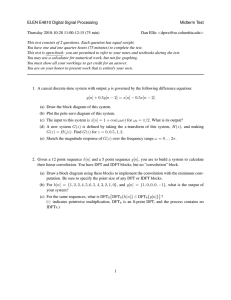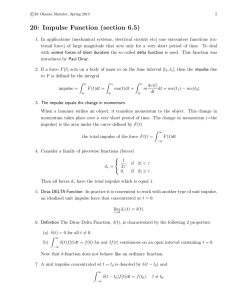CG. Convolution and Green’s Formula 1. Convolution.
advertisement
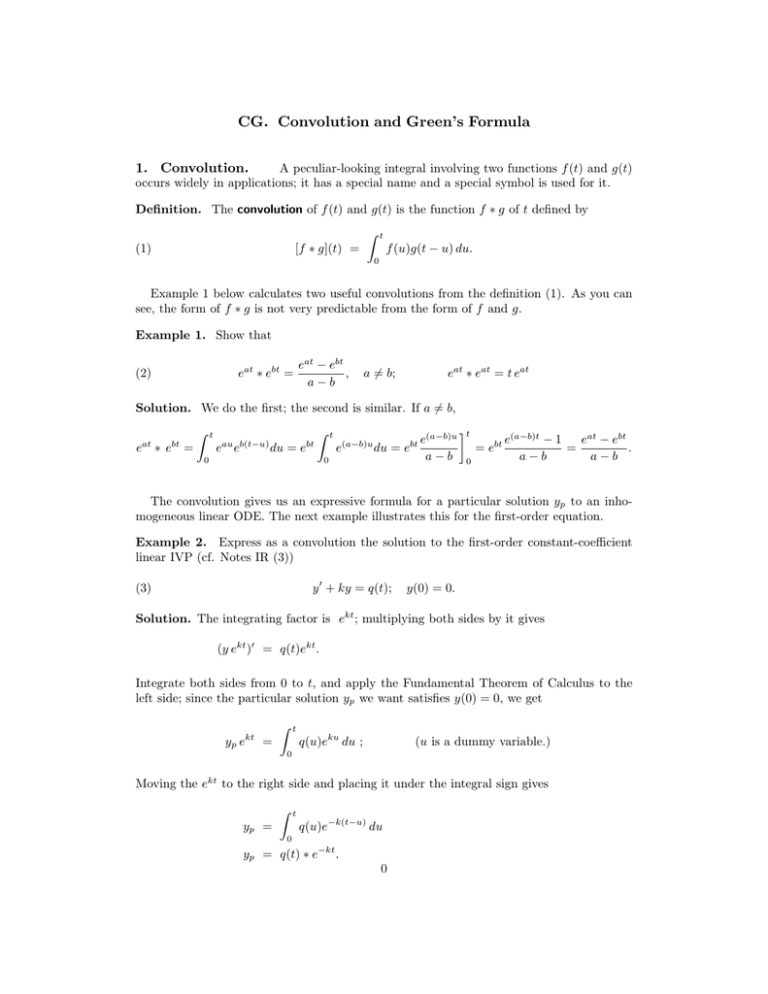
CG. Convolution and Green’s Formula 1. Convolution. A peculiar-looking integral involving two functions f (t) and g(t) occurs widely in applications; it has a special name and a special symbol is used for it. Definition. The convolution of f (t) and g(t) is the function f ∗ g of t defined by (1) [f ∗ g](t) = Z t f (u)g(t − u) du. 0 Example 1 below calculates two useful convolutions from the definition (1). As you can see, the form of f ∗ g is not very predictable from the form of f and g. Example 1. Show that eat ∗ ebt = (2) eat − ebt , a−b eat ∗ eat = t eat a 6= b; Solution. We do the first; the second is similar. If a 6= b, e at bt ∗e = Z t au b(t−u) e e du = e 0 bt Z t e (a−b)u du = e 0 bt e (a−b)u t a−b 0 = ebt e(a−b)t − 1 eat − ebt = . a−b a−b The convolution gives us an expressive formula for a particular solution yp to an inhomogeneous linear ODE. The next example illustrates this for the first-order equation. Example 2. Express as a convolution the solution to the first-order constant-coefficient linear IVP (cf. Notes IR (3)) y ′ + ky = q(t); (3) y(0) = 0. Solution. The integrating factor is ekt ; multiplying both sides by it gives (y ekt )′ = q(t)ekt . Integrate both sides from 0 to t, and apply the Fundamental Theorem of Calculus to the left side; since the particular solution yp we want satisfies y(0) = 0, we get yp ekt = Z t q(u)eku du ; (u is a dummy variable.) 0 Moving the ekt to the right side and placing it under the integral sign gives yp = Z t q(u)e−k(t−u) du 0 yp = q(t) ∗ e−kt . 0 CG. CONVOLUTION AND GREEN’S FORMULA 1 We see that the solution is the convolution of the input q(t) with the solution to the IVP (3) where q = 0 and the initial value is y(0) = 1. This is the simplest case of Green’s formula, which does the same thing for higher-order linear ODE’s. We will describe it in section 3. 2. Physical applications of the convolution. The convolution comes up naturally in a variety of physical sitations. Here are two typical examples. Example 3. Radioactive dumping. A radioactive substance decays exponentially: (4) R = R0 e−kt , where R0 is the initial amount, R(t) the amount at time t, and k the decay constant. A factory produces this substance as a waste by-product, and it is dumped daily on a waste site. Let f (t) be the rate of dumping; this means that in a relatively small time period [t0 , t0 + ∆t], approximately f (t0 )∆t grams of the substance is dumped. Find a formula for the amount of radioactive waste in the dump site at time t, and express it as a convolution. Assume the dumping starts at time t = 0. Solution. Divide up the time interval [0, t] into n equal intervals of length ∆u, using the times u0 = 0, u1 , u2 , . . . , un = t. amount dumped in the interval [ui , ui+1 ] ≈ f (ui )∆u ; by time t, this amount will have decayed for approximately the length of time t − ui ; therefore, according to (4), at time t the amount of waste coming from what was dumped in the time interval [ui , ui+1 ] is approximately f (ui )∆u · e−k(t−ui ) . Adding up the radioactive material in the pile coming from the dumping over each time interval, we get n−1 X f (ui )e−k(t−ui ) ∆u . total amount at time t ≈ 0 As n → ∞ and ∆u → 0, the sum approaches the corresponding definite integral and the approximation becomes an equality. So we conclude that Z t f (u)e−k(t−u) du = f (t) ∗ e−kt ; total amount at time t = 0 i.e., the amount of waste still radioactive at time t is the convolution of the dumping rate and the decay function. Example 4. Bank interest. On a savings account, a bank pays the continuous interest rate r, meaning that a sum A0 deposited at time u = 0 will by time u = t grow to the amount A0 ert . Suppose that starting at day t = 0 a Harvard square juggler deposits every day his take, with deposit rate d(t) — i.e., over a relatively small time interval [u0 , u0 + ∆u], he deposits approximately d(u0 )∆u dollars in his account. Assuming that he makes no withdrawals and the interest rate doesn’t change, give with reasoning an approximate expression (involving a convolution) for the amount of money in his account at time u = t. 2 18.03 NOTES Solution. Similar to Example 3, and left as an exercise. 3. Weight and transfer functions and Green’s formula. In Example 2 we expressed the solution to the IVP y ′ + ky = q(t), y(0) = 0 as a convolution. We can do the same with higher order ODE’s which are linear with constant coefficients. We will illustrate using the second order equation, (5) y ′′ + ay ′ + by = f (t), y(0) = 0, y ′ (0) = 0. The Laplace transform of this IVP, with the usual notation, is s2 Y + asY + bY = F (s) ; solving as usual for Y = L(y), we get 1 ; s2 + as + b using the convolution operator to take the inverse transform, we get the solution in the form called Green’s formula ( the function w(t) is defined below): Z t f (u)w(t − u) du . (6) y = f (t) ∗ w(t) = Y = F (s) 0 In connection with this form of the solution, the following terminology is often used. Let p(D) = D2 + aD + b be the differential operator; then we write 1 s2 + as + b w(t) = L−1 W (s) W (s) = G(t, u) = w(t − u) the transfer function for p(D), the weight function for p(D), the Green’s function for p(D). The important thing to note is that each of these functions depends only on the operator, not on the input f (t); once they are calculated, the solution (6) to the IVP can be written down immediately by Green’s formula, and used for a variety of different inputs f (t). The weight w(t) is the unique solution to either of the IVP’s (7) y ′′ + ay ′ + by = 0; y(0) = 0, y ′ (0) = 1; (8) y ′′ + ay ′ + by = δ(t); y(0) = 0, y ′ (0− ) = 0; in (8), the δ(t) is the Dirac delta function. It is an easy Laplace transform exercise to show that w(t) is the solution to (7) and to (8). In the next section, we will give a physical interpretation for the weight function and Green’s formula. Let us check out Green’s formula (6) in some simple cases where we can find the particular solution yp also by another method. Example 5. Find the particular solution given by (6) to y ′′ + y = A, y(0) = 0. Solution. From (7), we see that w(t) = sin t. Therefore for t ≥ 0, we have yp (t) = Z t A sin(t − u) du = A cos(t − u) 0 t 0 = A(1 − cos t). CG. CONVOLUTION AND GREEN’S FORMULA 3 Here the exponential response formula or the method of undetermined coefficients would produce the particular solution yp = A; however, A − A cos t is also a particular solution, since −A cos t is in the complementary function yc ; the extra cosine term is required to satisfy y(0) = 0. Example 6. Find the particular solution for t ≥ 0 given by (6) to y ′′ + y = f (t), where f (t) = 1 if 0 ≤ t ≤ π, and f (t) = 0 elsewhere. Solution. Here the method of Example 5 leads to two cases: 0 ≤ t ≤ π and t ≥ π: Z t t sin(t − u) du = cos(t − u) = 1 − cos t, 0 ≤ t ≤ π; Z t 0 f (u) sin(t − u) du = yp = 0π Z π 0 sin(t − u) du = cos(t − u) = −2 cos t, t ≥ π . 0 0 Terminology and results analogous to (6) hold for the higher-order linear IVP’s with constant coefficients (here p(D) is any polynomial in D) p(D)y = f (t), y(0) = y ′ (0) = . . . = y (n−1) (0) = 0; Green’s formula for the solution is once again (6), where the weight function w(t) is defined to be the unique solution to the IVP (9) p(D)y = 0, w(0) = w′ (0) = . . . w(n−2) (0) = 0, w(n−1) (0) = 1. Equivalently, it can be defined as the unique solution to the analogue of (8). 4. Impulse-response; interpretation of Green’s formula. We obtained Green’s formula (6) by using the Laplace transform; our aim now is to interpret it physically, to see the “why” of it. This will give us further insight into the weight function and the convolution operation. We know the weight function w(t) is the solution to the IVP (7) y ′′ + ay ′ + by = 0, y(0) = 0, y ′ (0) = 1. We think of this as modeling the motion of the mass in a spring-mass-dashpot system (we will take the mass m = 1, for simplicity). The system is initially at rest, but at time t = 0 the mass is given a kick in the positive direction, which imparts to it unit velocity: y ′ (0+ ) = 1. According to physical mechanics, to impart this unit velocity to a unit mass, the kick must have unit impulse, which is defined for a constant force F to be (10) Impulse = (force F )(length of time F is applied) . A kick is modeled as a constant force F applied over a very short time interval 0 ≤ t ≤ ∆u; according to (10), for the force to impart a unit impulse over this time interval, it must have magnitude 1/∆u: 1 = (1/∆u)(∆u) . 4 18.03 NOTES Input: force (1/∆u) applied over time interval [0, ∆u] Response: w(t) If the kick is applied instead over the time interval u ≤ t ≤ u + ∆u, the response is the same as before, except that it starts at time u: Input: force (1/∆u) applied over time interval [u, u + ∆u] Response: w(t − u) Finally, if the force is not a constant (1/∆u), but varies with time: F = f (u), by (10) the impulse it imparts over the time interval [u, u + ∆u] is approximately f (u)∆u, instead of 1, so the response must be multiplied by this factor; our final result therefore is (11) Input: force f (u) applied over [u, u + ∆u] Response: f (u)∆u · w(t − u). From this last it is but a couple of steps to the physical interpretation of Green’s formula. We use the Superposition principle for the IVP (5): if f (t) = f1 (t) + . . . fn (t), and yi (t) is the solution corresponding to fi (t), then y1 + . . . yn is the solution corresponding to f (t). In other words, the response to a sum of inputs is the sum of the corresponding responses to each separate input. Of course, the input force f (t) to our spring-mass-dashpot system is not the sum of simpler functions, but it can be approximated by such a sum. To do this, divide the time interval from u = 0 to u = t into n equal subintervals, of length ∆u: 0 = u0 , u1 , . . . , un = t, ui+1 − ui = ∆u . Assuming f (t) is continuous, f (t) ≈ f (ui ) over the time interval [ui , ui+1 ] Therefore if we set (12) fi (t) = f (ui ), ui ≤ t < ui+1 ; 0, elsewhere, i = 0, 1, . . . , n − 1 , we will have approximately (13) f (t) ≈ f0 (t) + . . . + fn−1 (t), 0<u<t. We now apply our superposition principle. According to (10), the response of the system to the input fi (t) described in (12) will be approximately (14) f (ui )w(t − ui )∆u; Applying the P superposition principle to (13), we find the response yp (t) of the system to the input f (t) = fi (t) is given approximately by (15) yp (t) ≈ n−1 X 0 f (ui )w(t − ui )∆u . CG. CONVOLUTION AND GREEN’S FORMULA 5 We recognize the sum in (15) as the sum which approximates a definite integral; if we pass to the limit as n → ∞, i.e., as ∆u → 0, in the limit the sum becomes the definite integral and the approximation becomes an equality and we get Green’s formula: (16) yp (t) = Z t f (u) w(t − u) du system response to f (t) 0 In effect, we are imagining the driving force f (t) to be made up of an infinite succession of infinitely close kicks fi (t); by the superposition principle, the response of the system can then be obtained by adding up (via integration) the responses of the system to each of these kicks. Green’s formula is a very remarkable one. It expresses a particular solution to a secondorder differential equation directly as a definite integral, whose integrand consists of two parts: a factor w(t − u) depending only on the left-hand-side of (5) — that is, only on the spring-mass-dashpot system itself, not on how it is being driven — and a factor f (t) depending only on the external driving force. For example, this means that once the unit impulse response w(t) is calculated for the system, one only has to put in the different driving forces to determine the responses of the system to each. Green’s formula makes the superposition principle clear: to the sum of input forces corresponds the sum of the corresponding particular solutions. Still another advantage of Green’s formula is that it allows the input force to have discontinuities, as long as they are isolated, since such functions can always be integrated. For instance, f (t) could be a step function or the square wave function. Exercises: Section 2H M.I.T. 18.03 Ordinary Differential Equations 18.03 Notes and Exercises c Arthur Mattuck and M.I.T. 1988, 1992, 1996, 2003, 2007, 2011 1
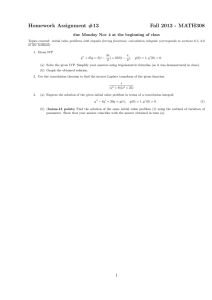
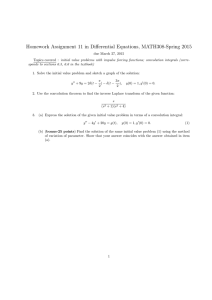
![2E2 Tutorial sheet 7 Solution [Wednesday December 6th, 2000] 1. Find the](http://s2.studylib.net/store/data/010571898_1-99507f56677e58ec88d5d0d1cbccccbc-300x300.png)
